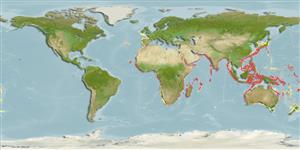Common names from other countries
>
Perciformes/Bembropoidei (Duckbill flatheads) >
Bembropidae (Duckbill flatheads)
Etymology: Bembrops: Greek, bembras, -ados = a kind of anchovy m+ Greek, ops = appearance (Ref. 45335); caudimacula: Specific name from the Latin 'cauda' meaning tail and 'macula' meaning spot or stain, referring to the dark spot on the caudal fin..
More on author: Steindachner.
Environment: milieu / climate zone / depth range / distribution range
Écologie
marin bathydémersal; profondeur 186 - 500 m (Ref. 13203). Deep-water
Indo-West Pacific: Japan and Korea, south to Borneo and northeastern Australia, west to the Andaman Sea and Indian Ocean, and in the Gulf of Aden. Eastern Atlantic: only in the Gulf of Guinea.
Taille / Poids / Âge
Maturity: Lm ? range ? - ? cm
Max length : 24.1 cm TL mâle / non sexé; (Ref. 115021); poids max. publié: 94.00 g (Ref. 115021)
Épines dorsales (Total) : 6; Rayons mous dorsaux (Total) : 14 - 15; Rayons mous anaux: 16. Anterior portion of first dorsal fin darkish. Usually 6 scale rows between lateral line and origin of anal fin (Ref 12932).
Life cycle and mating behavior
Maturities | Reproduction | Spawnings | Egg(s) | Fecundities | Larves
Das, M.K. and J.S. Nelson, 1996. Revision of the percophid genus Bembrops (Actinopterygii: Perciformes). Bull. Mar. Sci. 59(1):9-44. (Ref. 13203)
Statut dans la liste rouge de l'IUCN (Ref. 130435)
CITES (Ref. 128078)
Not Evaluated
Menace pour l'homme
Harmless
Utilisations par l'homme
Outils
Articles particuliers
Télécharger en XML
Sources Internet
Estimates based on models
Preferred temperature (Ref.
115969): 11 - 18.6, mean 13.1 (based on 226 cells).
Phylogenetic diversity index (Ref.
82804): PD
50 = 0.5000 [Uniqueness, from 0.5 = low to 2.0 = high].
Bayesian length-weight: a=0.00309 (0.00180 - 0.00531), b=3.07 (2.92 - 3.22), in cm Total Length, based on LWR estimates for this species & (Sub)family-body (Ref.
93245).
Niveau trophique (Ref.
69278): 4.0 ±0.4 se; based on size and trophs of closest relatives
Fishing Vulnerability (Ref.
59153): Low vulnerability (14 of 100).
